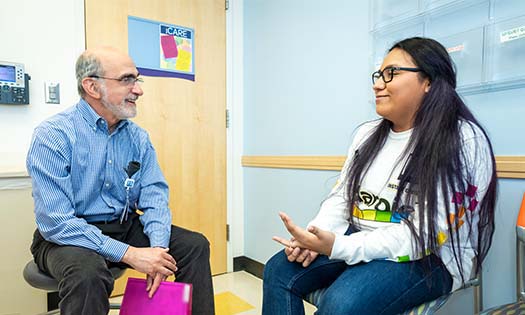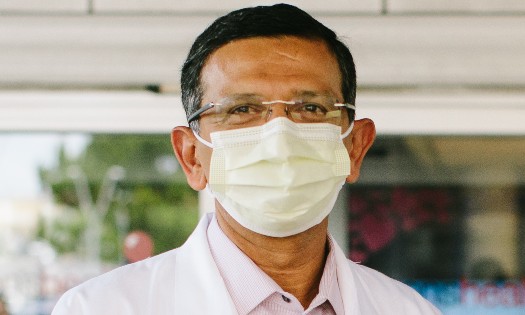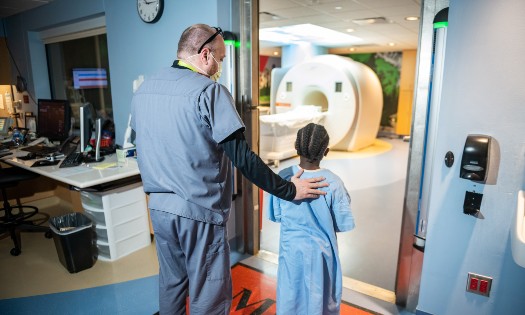In January 2022, a 17-month-old boy arrived at Children’s Medical Center Dallas, part of Children’s Health℠, with kidney failure from primary hyperoxaluria type 1 (PH1). His previous providers had started him on lumasarin (Oxlumo®) when he was 4 months old. At the time, lumasarin was the only FDA-approved medication for PH1, having received approval only months earlier. Unfortunately, the patient’s aggressive form of PH1 continued to progress quickly, causing kidney failure and the need for dialysis by the time he was 9 months old.
Despite dialysis and medication, the patient was still accumulating excess oxalate throughout his body when he came to Children’s Health. Raymond Quigley, M.D., Pediatric Nephrologist at Children’s Health and Professor of Pediatrics at UT Southwestern, optimized the lumasarin treatment and initiated transplant discussions with experts at the Pediatric Solid Organ Transplant Center at Children’s Health. Since PH1 originates in the liver, the team took steps for a combination liver-kidney transplant.
The impact of hyperoxaluria on organs
People with PH1 have a mutated AGXT gene that impairs the production and efficacy of the liver-specific enzyme alanine-glyoxylate aminotransferase (AGT). This enzyme helps process a toxic metabolite, called glyoxylate.
A person with PH1 doesn’t make any, or enough AGT. As a result, glyoxylate converts to oxalate, which passes to the kidneys, forming kidney stones or causing nephrocalcinosis. Systemic oxalosis can occur as oxalate accumulates in organs, bones and blood.
Lumasarin is a small interfering RNA (siRNA) medication that targets a glycolate oxidase enzyme upstream of AGT. It reduces the amount of oxalate produced by the liver by 65% to 71%, leaving an amount the kidneys can manage. In this way, lumasarin treatments can prevent kidney damage and failure.
But the only cure for PH1 is a liver transplant with an organ that makes AGT. Patients with kidney failure also need a new kidney.
PH1 medication makes kidney-only transplant possible
The transplant team placed the patient on the national waitlist. He was 2 years old at the time and too small to receive a segment of a liver from an adult living donor like his father, even though the dad was a match.
“Finding a deceased organ donor match for infants and toddlers can be difficult because organs have to fit their small bodies, as well as be blood type and antigen compatible,” says Dr. Quigley.
After waiting more than a year, the patient developed worsening severe disease complications despite daily dialysis. His health was deteriorating. The now 3-year-old patient was still too small to receive a liver segment from his father. But he could receive one of his father’s kidneys – an option that wouldn’t have been possible without lumasarin to prevent oxalate damage to the donor kidney. With lumasarin, the patient could delay getting a liver segment from his father until he’s older, bigger and stronger.
The patient underwent a kidney transplantation in June 2024, just a few months shy of his fourth birthday. He is believed to be the youngest patient with PH1 to receive just a kidney – not a liver – thanks to the use of lumasarin.
Since the transplant, the patient’s serum oxalate levels have dropped from 50 micromoles per liter (μmol/L) to about 10 μmol/L. (Normal levels range from 1 to 3 μmol/L.) Dr. Quigley expects the levels will continue to decrease as excess oxalate leaves body tissues.
“We’re still learning about the long-term effects of PH1 medications,” says Dr. Quigley. “The patient may continue with medication and not need a liver transplant, or he may get a liver segment from his father and not need medication.”
In the future, the patient may benefit from another PH1 medication, nedosiran (Rivloza®), approved in October 2023 for adults and children 9 and older. This siRNA medication targets the liver-specific enzyme lactate dehydrogenase (LDH), lowering oxalate levels by as much as 56%.
“Studies are underway to gauge the efficacy of giving patients both drugs to achieve normal oxalate levels and protect the kidneys,” says Dr. Quigley.
Caring for children with PH1
PH1 is an extremely rare, inherited autosomal recessive disorder that affects as few as 1 to 3 in one million people in North America and Europe. When the patient was born, his parents were unaware that they each carried a mutated AGXT gene. But when they were expecting again, prenatal tests showed their unborn twins also had PH1. Thanks to this early diagnosis, lumasarin treatments began soon after birth, and the twins, now 2, show no signs of kidney damage.
“The development of PH1 medications means children with this rare metabolic disorder may never need an organ transplant,” says Dr. Quigley.
Why Children’s Health leads in rare kidney disorders and transplant care
This groundbreaking case underscores why Children’s Health is recognized as a national leader in pediatric nephrology and pediatric transplant medicine. Through multidisciplinary collaboration, Children’s Health delivered a pioneering, life-saving treatment strategy for one of the most complex and rare metabolic disorders. Our expertise in managing conditions like PH1 – coupled with access to the latest FDA-approved therapies and innovative surgical solutions – offers patients not only hope but transformative outcomes. By pushing the boundaries of what’s possible in kidney care, Children’s Health is shaping the future of pediatric nephrology and ensuring that even the rarest disorders are met with the highest standard of care.
Learn more about innovations in pediatric nephrology at Children’s Health.


